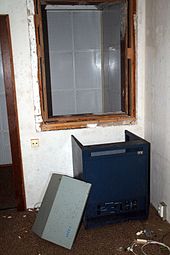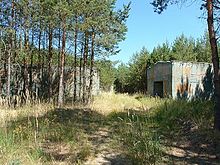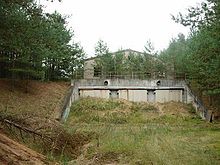Bunker complex 5000
The bunkers of the complex 5000 , also known internally as "Investkomplex 17", were part of a military investment program for the planned increase in the defense capability of the Ministry for National Defense of the GDR , which was also carried out with Order No. 10/73 of the MfS of February 5, 1973 was closely related. All measures to keep the investment program confidential that were subject to this order were carried out under the cover name "Filigree". The structures were built on behalf of the National Defense Council (NVR) of the GDR and were intended to protect the leadership and communication with the military ( NVA ) and the allied armed forces of the Warsaw Pact in the event of a crisis or war .
Single objects
17/5001: Main lead office of the National Defense Council of the GDR ("Perle")
"Perle" was the code name for the bunker facility in Prenden ( Wandlitz municipality ), which was built on three levels underground on Ützdorfer Straße, between the Stromberge and the Bogensee . The 7,500 m² bunker, built between 1978 and 1983, is one of the largest and best-known underground protective structures in the area of the former GDR. The system, officially known as special structure 17/5001 (SBW 17/5001) , was considered a technical masterpiece and when it was put into service in 1983 it was probably the most complex structure of its kind in the entire Eastern Bloc .
The message center installed in the bunker was always operational. In daily service there were open and covered connections with the Warsaw contracting states, the central management areas of the GDR and the district operations command. With the aim of maintaining secrecy, the headquarters was assigned the designation “Auxiliary Message Center 3” (HNZ 3) in the NVA's message system. Under this designation, it was understood by the technical and operating staff of other communication centers as a supporting element in the system. With appropriately prepared lines for communication, it was closely connected to the protected large message centers of the Ministry of National Defense ( main message center , HNZ 2, HNZ 4, HNZ 7, HNZ 8).
Large parts of the three-storey facility are elastically mounted in order to be able to intercept the shock wave of a nuclear weapon explosion (protection class A). For this purpose spring mechanisms and nitrogen- filled pneumocord shock absorbers (PKU) were used. Almost 350 people (according to the handover protocol), including the members of the NVR and its chairman Erich Honecker , found refuge here. Colloquially, the object 5001 is therefore also referred to as the Honecker bunker .
It is remarkable that the bunker was only of subordinate military importance. Weapons systems were not controlled from inside the bunker, nor were there any larger computing systems for simulating situation situations in the facility. The only technical infrastructure that was not required for locking operation was the telephone system. The entire structure was designed to provide a kind of 'bomb-proof conference room' for around 50 people from the National Defense Council.
It is also worth mentioning that there was a small recording studio in the bunker, from which speeches to the population could be made via the GDR radio stations in the event of a crisis .
After the fall of the Berlin Wall and reunification in 1990, the bunker was taken over by the Bundeswehr , examined, and sealed and abandoned in 1993. The above-ground camouflage structures were torn down. The entrances and concrete hoods below for the supply and exhaust air were filled in with excavation by the local forestry authority due to the onset of bunker tourism . The facility is now a listed building . The system could be viewed for the first and last time after registration from August to October 2008. At the end of 2008 the entrance area was sealed with a concrete seal. The northern part of the barracks is privately owned, entry is not permitted. The southern part in the forest and the "Monte Erich" consisting of overburden , however, are accessible for walkers.
Data:
- Usable area: 7,500 m²
- Enclosed space: 96,000 m³
- Volume: 65,000 m³
- 170 rooms
- 24 bearings
- Geographical location: 52 ° 46 ′ 42.5 " N , 13 ° 32 ′ 22.9" E
17/5002: radio transmission center (protected transmission point)
Object 17/5002 is not far from Prenden , between Marienwerder and Klandorf . It is the bunkered radio transmission center belonging to the object SBW 17/5001 of the main command post of the National Defense Council of the GDR. The bunker was designed as a two-storey protection class B and was designed for approx. 110 people. The radio transmitters installed in the bunker were prepared for entry into the prepared radio networks and facilities of the military organs of the GDR and the Warsaw Pact.
In the event of war, the radio transmitters of the radio transmission center would have been remote-controlled from the radio reception center installed in object 17/5001. For reasons of camouflage, this was only designed for reception so that it was not possible to locate and thus endanger the main object.
- Geographical location: 52 ° 51 ′ 29.2 ″ N , 13 ° 36 ′ 5.2 ″ E
17/5005: MfS guide bunker
The object, also known as the Mielke bunker , is a two-story bunker of protection class B, which would have protected 160 employees of the Ministry for State Security (MfS) and the Minister for State Security of the GDR, Erich Mielke , and is located within a cordoned-off barracks area of around 27 hectares Size north of Biesenthal . Despite its number 5000, it is referred to in the literature as not belonging to the actual bunker complex 5000, but as an independent object. Today there is a composting facility here . Since it was sealed in 1993, this bunker has also suffered a lot from bunker tourism and, as a result, vandalism and destruction. So-called control inspections are now taking place again, the last on 11/12. April 2015.
- Geographical location: 52 ° 47 ′ 17.2 ″ N , 13 ° 36 ′ 0.1 ″ E
17/5011: message bunker
This protective structure, which is often incorrectly designated as object 17/5011, is the sub-object 122. The designation 17/5011 is the superordinate name of the follow-up investment, under which further objects were built in 1986. With the sub-object 122, the troposphere reception center "Am Schwarzen Weg" was expanded. These bunkers are located on the site of object 5001 and are approx. 600 meters from the main structure. In these bunkers, the mobile tropospheric reception technology should be sheltered. In the event of an incident, they would have been manned by a communications group of the State Security Committee of the USSR.
The bunker part 122 was only completed in 1990 and sealed again a short time later. It can no longer be viewed.
The bunkers of the sub-object 106 are partly used as a shooting range.
- Geographical location: 52 ° 47 ′ 0.9 ″ N , 13 ° 32 ′ 13.6 ″ E
17/5020: helipad (port of call)
Object 17/5020, also known internally as the “starting point”, was located on the Bernau - Wandlitz connecting road and was built as a helicopter landing pad and courier, reporting and distribution center three kilometers from the forest settlement . The proximity to the residence of the members of the Politburo was mainly intended to ensure the “covered retreat” of the members of the NVR and the remaining privileged members of the government by plane or helicopter to the east. For an evacuation, the government could have been flown directly from the forest settlement by helicopter. The bunkers are smaller and are of secondary importance and function in Complex 5000. There are several vehicle bunkers (six of them under the standby buildings) and a central FB-75 complex. There is also a protected cellar in the tower building and several small bunkers, as well as FB-3 crew bunkers on the site. Most of the facility has been demolished. Only the two large bunker structures, which were located under the accommodation barracks, as well as the large garage bunker immediately behind it, were left in place. Today they are used as housing for bats .
Another interesting system, belonging to object 17/5020, was well hidden in the forest and fenced in by a high-voltage safety system (HSA), about 1000 meters away on the other side of the federal highway 11 . This is the sub - object TO 28.1, the so-called near marking point (NMP) for the airfield . The antenna system of the type SHG 19/70 erected there at a height of 19 meters , had a span of 70 meters and was stretched parallel to the axis of the airfield.
- Geographical location: 52 ° 43 ′ 0.9 ″ N , 13 ° 32 ′ 11.4 ″ E
17/5021: Partially protected broadcasting point
The object 17/5021 was designed mainly as a tropospheric transmitter and served to secure the communication links in the highest encryption level. At the same time it was an alternate transmission point for object 17/5002 for conventional radio traffic with primarily mobile radio stations . With a few exceptions, all antenna systems at the transmitter were installed as earth antennas and thus installed in a relatively protected manner. The facility was sealed in 2004 and can no longer be viewed.
- Geographical location: 52 ° 54 ′ 27.3 ″ N , 13 ° 45 ′ 12.9 ″ E
housing
The 5000 management complex also included a residential building site for the accommodation of the employees working in the properties in relative proximity to the facilities to ensure that the individual protective structures were ready for use quickly. This was realized in the form of GDR-typical prefabricated buildings partly in Bernau and later in Biesenthal.
Unrealized individual objects
For cost reasons, the following individual objects were not realized in deviation from the original planning:
- Object 17/5004 (central data processing system)
- Object 17/5012 (change control point)
- Object 17/5022 (second partially protected transmission point)
Counterpart of the FRG
The counterpart in the Federal Republic of Germany was the alternative seat of the constitutional organs of the federal government in the event of a crisis or defense to maintain their functionality in Rhineland-Palatinate.
literature
- Paul Bergner: Nuclear Bunker - Cold War - Dolphin program. On the trail of the bunkers built for the Cold War . Heinrich-Jung-Verlagsgesellschaft, Zella-Mehlis et al. 2007, ISBN 978-3-930588-78-7 .
- Paul Bergner: "Filigree" command. On the trail of interesting bunkers. The bunkers of the "Complex 5000" and other important facilities . 6th revised edition. FB-Verlag, Basdorf 2008, ISBN 978-3-930588-85-5 ( FBV 2).
- Stefan Best: Secret bunker systems of the GDR . Motorbuch Verlag, Stuttgart 2003, ISBN 3-613-02332-6 .
- Hans Werner Deim, Hans-Georg Kampe, Joachim Kampe, Wolfgang Schubert: The military security of the GDR in the Cold War. Contents, structures, bunkered management positions, facilities. Meißler, Hönow 2008, ISBN 978-3-932566-80-6 .
- Jürgen Freitag, Hannes Hensel: Honecker's secret bunker 5001. Secrets and history (s) of the most modern bunker in the GDR . Motorbuch-Verlag, Stuttgart 2010, ISBN 978-3-613-03216-3 .
- Joachim Kampe: Wostok - the news center in the center of the military power of the GDR. CD ( PDF ). Project and publishing house Meißler, Hönow 2004, ISBN 3-932566-60-2 .
- Martin Kaule: Fascination Bunker: Stone Evidence of European History , Christoph-Links-Verlag, Berlin 2014, ISBN 978-3-86153-761-8 , Google Books .
- Agreement on the communication links between the central leadership areas dated March 30, 1989, GVS No.:A 757900, guideline for planning, organizing and ensuring communication links for the leadership of the GDR from the main lead office of the party and state leadership GVS MfS 0008-20 / 88
Web links
- Bunker5001.com (Official 3D photo documentation of the Honecker bunker)
- In the belly of the Cold War . one day , July 16, 2008
- Photos and detailed description of the structures of the complex 5000
- Review of the nuclear bunker Cold War Program Dolphin .
Individual evidence
- ↑ Johannes Frewel: Time capsule from the Cold War. In: Spiegel Online . August 4, 2008, accessed August 6, 2008 .
- ↑ Friday, Hensel: Honecker's secret bunker 5001 . P. 59
- ↑ Bunker5001.com - Current section - "The resolution"
- ↑ Bunker5001.com -Rubric WebID- "ID 309 - TO 106"
- ↑ Stefan Best: Secret bunker systems of the GDR - p. 55
- ↑ Stefan Best: Secret bunker systems of the GDR - p. 63
- ↑ Stefan Best: Secret bunker systems of the GDR - p. 63








